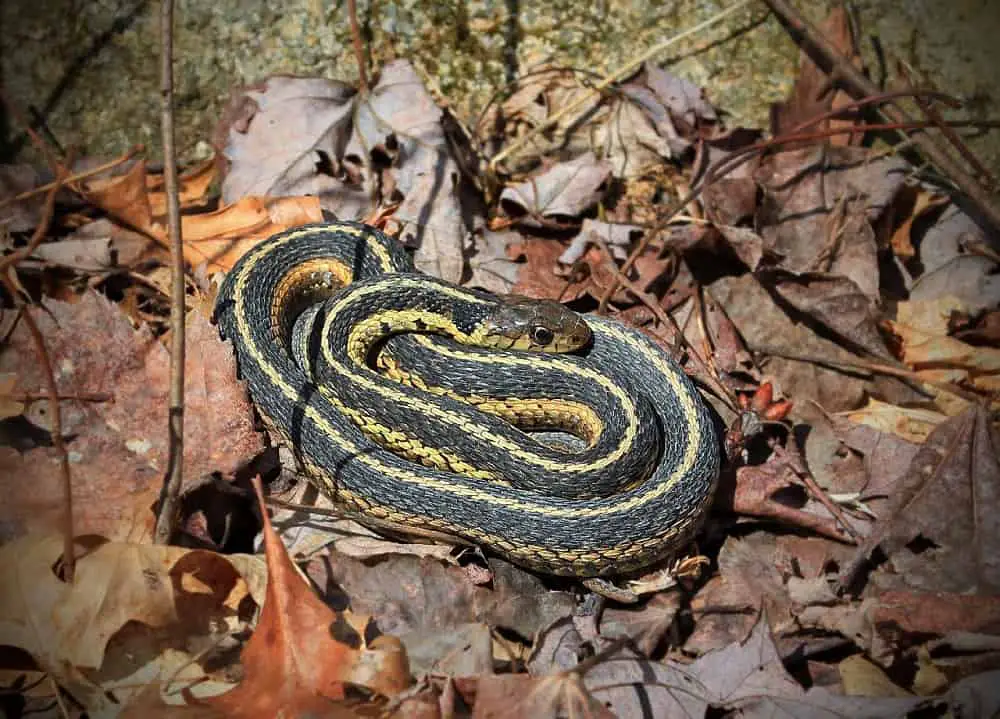
Garter snakes are common snakes found in gardens and backyards throughout the United States. When you find one of these snakes in your garden, how do you identify them? In this post, we list all the types of Garter snakes.
Thirty-five species of Garter snakes are found in North America, Quebec, Southern Ontario, and the Gulf of Mexico. They are the Common, Sierra, Butler’s, Santa Cruz, Mexican, Western Terrestrial, Short-headed, Bogert’s, Goldman’s, Checkered, Plains, and Northwestern Garter snakes, to name a few.
Garter snakes are intriguing and a vital part of the ecosystem. If you want to know how many species exist, look no further; they are all listed here.
The 35 Types of Garter Snakes
- Bogert’s Garter Snake – Thamnophis bogerti
- Santa Cruz Garter Snake – Thamnophis atratus
- Butler’s Garter Snake – Thamnophis butleri
- Common Garter Snake – Thamnophis sirtalis
- Short-headed Garter Snake – Thamnophis brachystoma
- Conant’s Garter Snake – Thamnophis conanti
- Golden-headed Garter Snake – Thamnophis chrysocephalus
- Black-necked Garter Snake – Thamnophis cyrtopsis
- Western Terrestrial Garter Snake – Thamnophis elegans
- Sierra Garter Snake – Thamnophis couchii
- Mexican Garter Snake – Thamnophis eques
- Exiled Garter Snake – Thamnophis exsul
- Mexican Wandering Garter Snake – Thamnophis errans
- Giant Garter Snake – Thamnophis gigas
- Mesoamerican Highlands Garter Snake – Thamnophis fulvus
- Godman’s Garter Snake – Thamnophis godmani
- Sumichrast’s Garter Snake – Thamnophis sumichrasti
- Two-striped Garter Snake – Thamnophis hammondii
- Checkered Garter Snake – Thamnophis marcianus
- Liner’s Garter Snake – Thamnophis lineri
- Plains Garter Snake – Thamnophis radix
- Madrean Narrow-headed Garter Snake – Thamnophis unilabialis
- Tamaulipan Montane Garter Snake – Thamnophis mendax
- Mexican Alpine Blotched Garter Snake – Thamnophis scalaris
- Southern Durango Spotted Garter Snake – Thamnophis nigronuchalis
- Tepalcatepec Valley Garter Snake – Thamnophis postremus
- Northwestern Garter Snake – Thamnophis ordinoides
- Western Ribbon Snake – Thamnophis proximus
- Rossman’s Garter Snake – Thamnophis rossmani
- Eastern Ribbon Snake – Thamnophis sauritus
- Mesa Central Blotched Garter Snake – Thamnophis scaliger
- Narrow-headed Garter Snake – Thamnophis rufipunctatus
- Mexican Pacific Lowlands Garter Snake – Thamnophis validus
- Mexican Black-bellied Garter Snake – Thamnophis melanogaster
- Yellow-throated Garter Snake – Thamnophis pulchrilatus
The Garter Snake, the Most Common Type of Snake
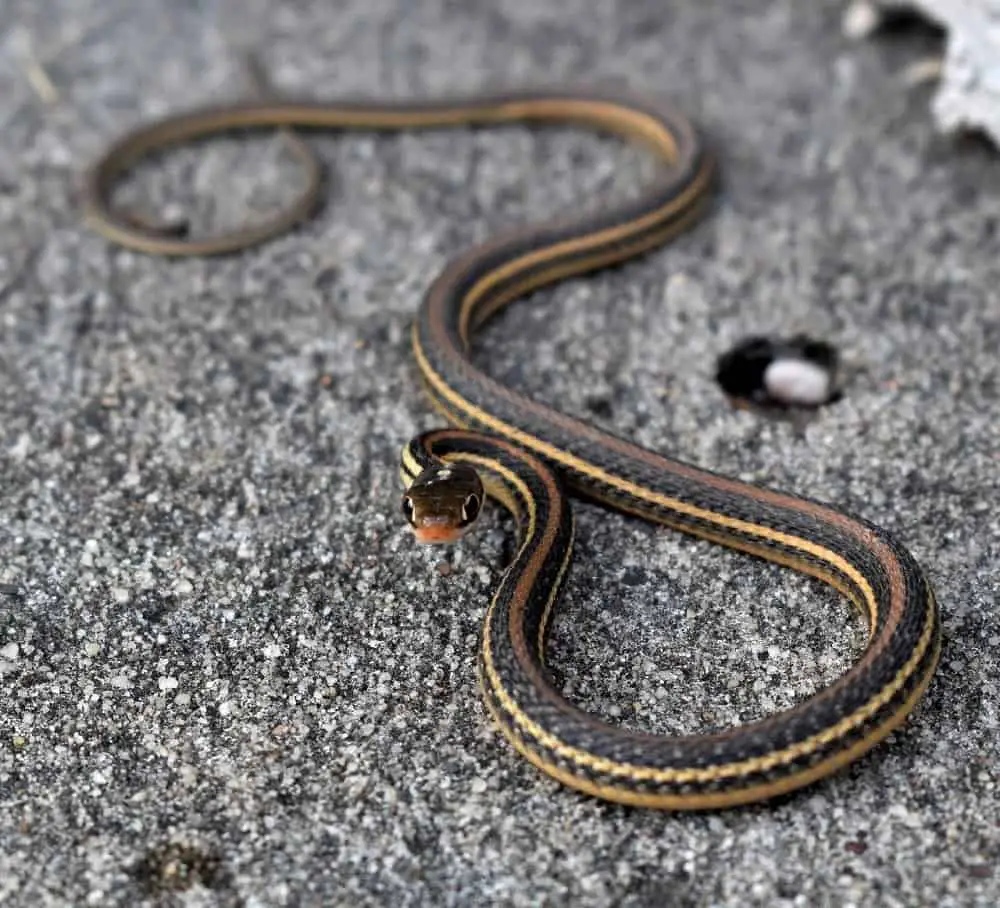
There are multiple species and sub-species of garter snakes here; we will talk about 11 species.
Garter snakes are the most common type of snakes found in gardens and backyards all over America. Because Garter snakes are relatively harmless to humans, they are often kept as pets. Some of the species are mildly venomous but not dangerous to humans.
Most Garter snakes have three longitudinal stripes, one on the back and one on each lower side of the body, and they come in various colors depending on the species. The stripes can be green or yellow in most species, but this color can vary with region and species.
Some garter snakes have patterns between their stripes that make them look checkered, and some can even appear stripe-less.
Garter snakes are small, between 23 to 30 inches, but some have been recorded to grow up to 5 feet long. Their bodies are described as slender, with a ridge of scales down the center of their bodies. Most Garter snake’s tongues are dual-colored.
They live in meadows, woodlands, and grassy areas near water. Garter snakes are primarily active during the day. They are highly terrestrial, fast-moving, and can climb into vines and shrubs; some Garter species climb more than others and are excellent swimmers.
Garter snakes give off a bad-smelling musk when they are threatened or mishandled. Many predators hunt Garter snakes like crows, hawks, bears, snapping turtles, bullfrogs, raccoons, squirrels, and foxes.
Garter snakes living in colder climates will hibernate during the winter in large groups in dens. Hundreds of garter snakes have been found together during hibernation; one with 8,000 snakes was in Canada. They travel long distances to a communal den for hibernation.
They mainly eat amphibians, earthworms, and fish but will grab other small prey that comes along. The snakes catch their prey with their quick reflexes and sharp teeth. The saliva of some Garter snakes contains a mild neurotoxin that causes paralysis that makes it easier to swallow their prey. Garter snakes swallow their food whole just like most snakes.
The Common Garter Snake – Thamnophis sirtalis
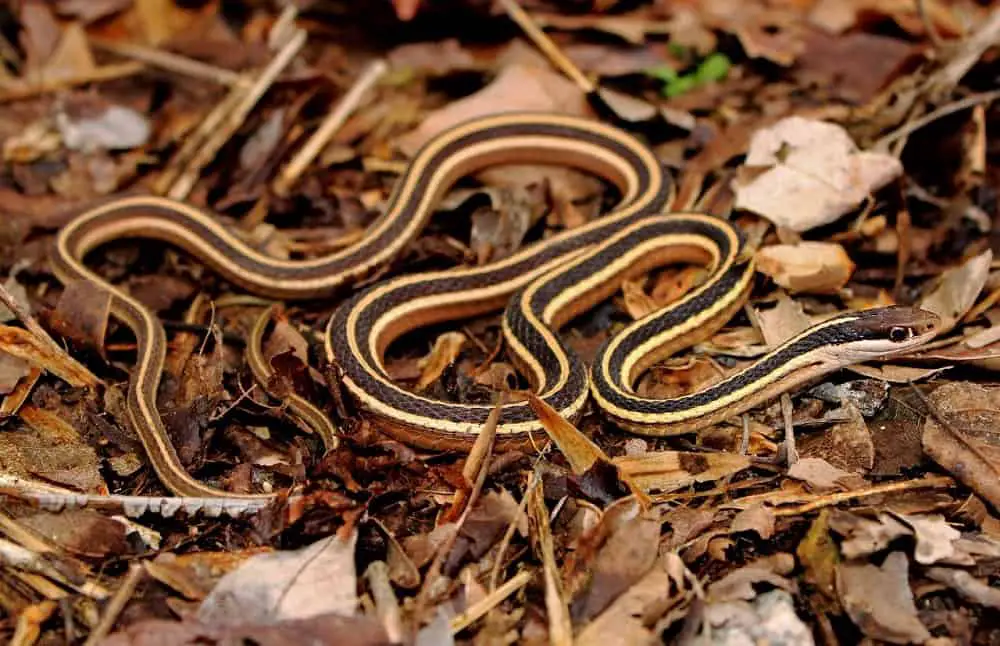
The common Garter snake comes in several color variations but generally has a dark-colored body covered with brown, olive, black, and gray scales. They have three stripes running down the length of their bodies that are usually yellow, red, blue, white, brown, or a shade of green.
The Common Garter snake has a red tongue that is black-tipped. Garter snakes are usually 18.1 to 54 inches long and typically weigh 5.30 oz.
They mainly eat fish, amphibians, crayfish, insects, or other snakes. They are non-venomous but have a gland above the upper jaw that can produce a toxic secretion that subdues prey.
They are primarily found in the United States, Canada, and Mexico. The female will choose her mating partner, but males will mate with more than one female in a breeding season.
After successful mating, the female Garter snake will go back to her summer territory and start feeding. Her young will incubate inside her for 2-3 months. She will give birth to between 10 to 70 live young Garter snakes. As soon as the babies are born, they are independent and start on their own.
Eastern Ribbon Snake – Thamnophis saurita
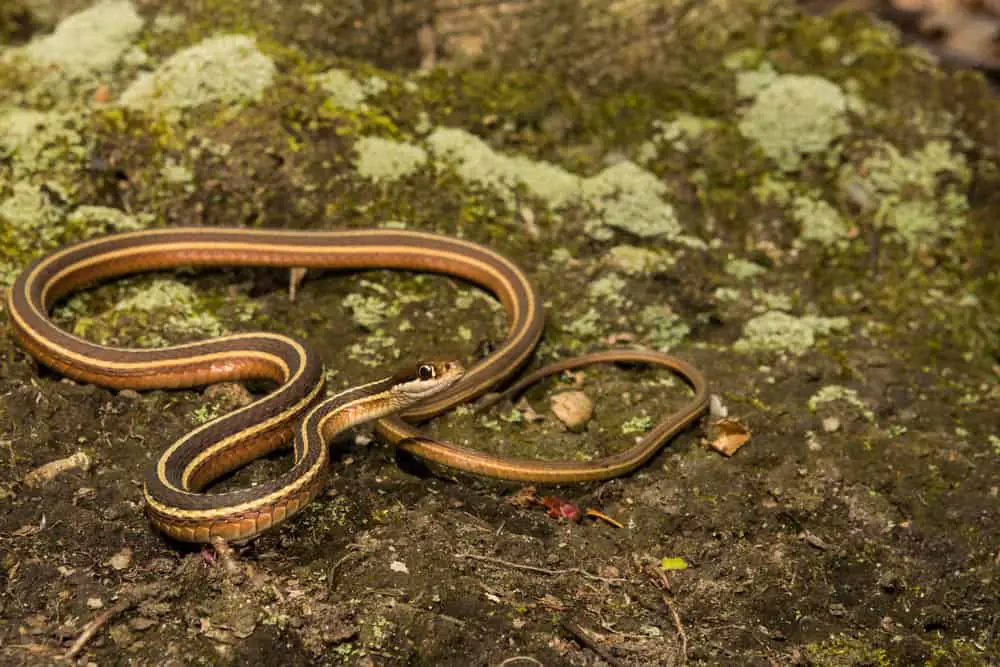
The Eastern Ribbon snake is brown to almost black and has three bright yellow or cream stripes; one down its back and one down each side of the body. The snout and entire head of this snake are brown, the lips and under its head are white. They are around 18 to 26 inches long, slender with a long tail.
The Eastern Ribbon Garter snake is semi-aquatic and always near water. They live in several habitats like grass plains, grassy ditches, marshes, streams, and woodlands near water and wetland areas in meadows. This species can even be found in suburban areas with the same environments.
They usually hunt in the water and prey on fish and amphibians.
They are not aggressive and rarely bite but, when threatened, will defecate and spray a musky residue. Camouflage is what keeps this snake hidden from predators.
Plains Garter Snake – Thamnophis radix
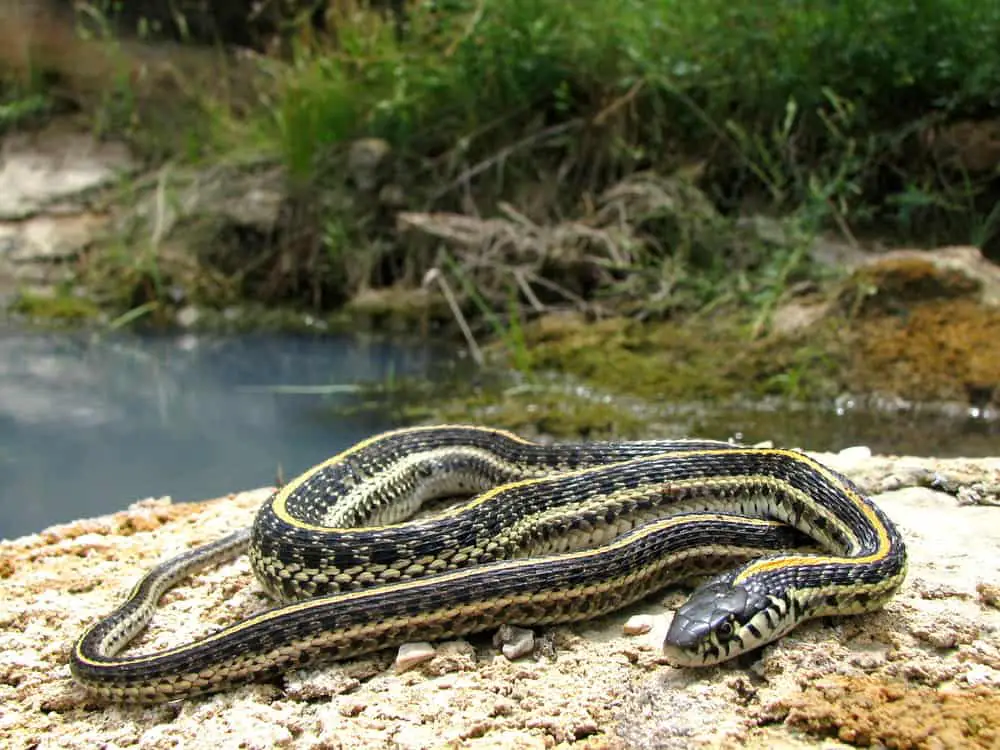
The Plains Garter snake is gray-green with a bright orange stripe down the back and a yellow-green stripe down each side of its body, and light-yellow spots on the top of its head. They are generally 15 to 28 inches long.
They can be found in grasslands near water sources. They are well adapted to urban areas with a large population; you will likely see them in your area.
The Plains Garter snake is tolerant of cold weather and feeds mainly on amphibians, earthworms, and slugs. They have been seen hunting small birds and mammals like the Bank Swallow and Eastern Meadowlark.
Black-necked Garter Snake – Thamnophis cyrtopsis
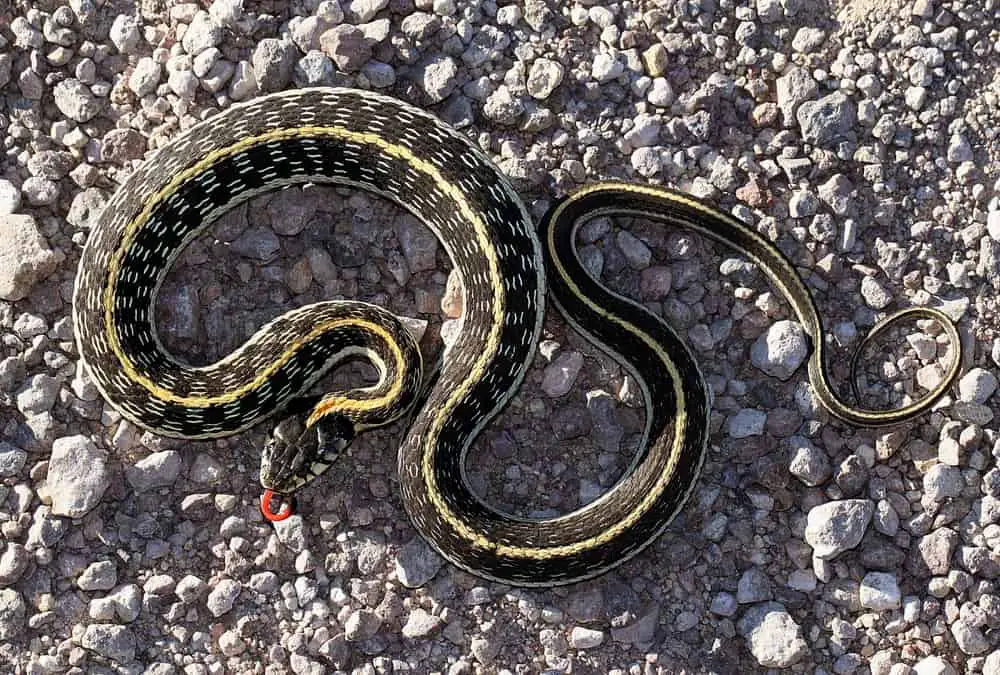
This Garter snake is dark olive with a yellow-orange stripe down its back and a yellow to white stripe down each side of its body.
The Eastern Black-necked Garter snake is small, only 20 inches long, with a checkered black and yellow pattern between the three stripes on its body.
They are found in many habitats like arid grasslands, woodlands, and desert landscapes that are always near water.
Their preferred prey are toads, tadpoles, frogs, and some poisonous species like the Sonoran Desert toad but will also eat skinks, earthworms, salamanders, birds, and crustaceans.
Black-necked Garter Snakes are often seen near cattle tanks since they are so dependent on water.
Checkered Garter Snake – Thamnophis marcianus
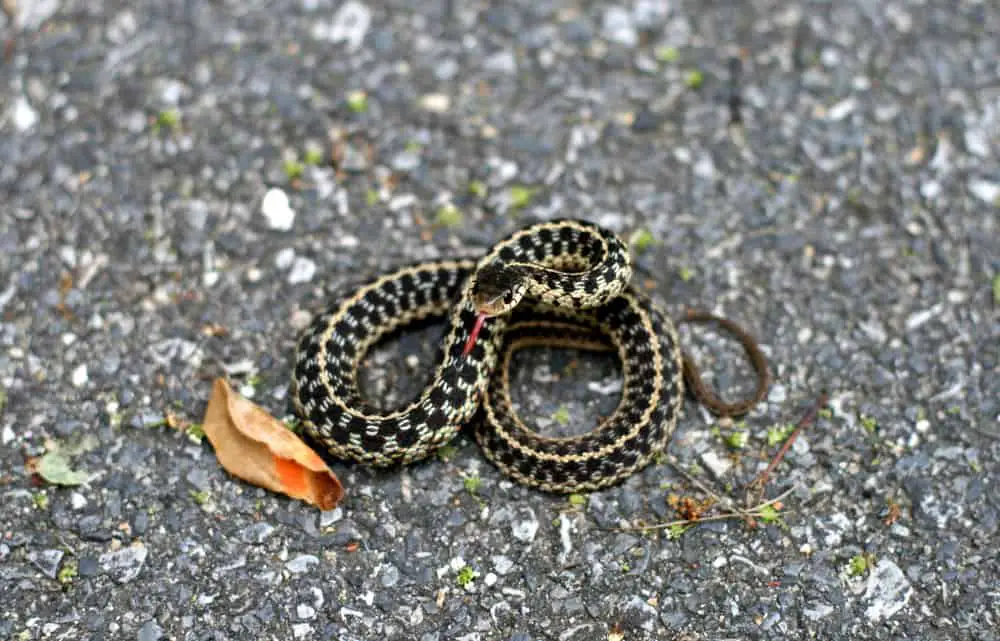
The Checkered Garter snake is green colored with three orange or yellow stripes; one down the center of its back and one down each side of the body, and a black checkerboard pattern on its back. These snakes measure 18 to 24 inches long. It has yellow or cream crescent marks on the sides of its head and a dark blotch on the neck.
It can be found in grassland and desert habitats near water sources, like lakes, rivers, wetlands, cattle tanks, and canals. These snakes are very good at finding water sources in desert habitats.
These snakes are opportunistic hunters that feed on various prey like salamanders, frogs, toads, small fish, earthworms, crayfish, lizards, slugs, and other snakes.
Sierra Garter Snake – Thamnophis couchii
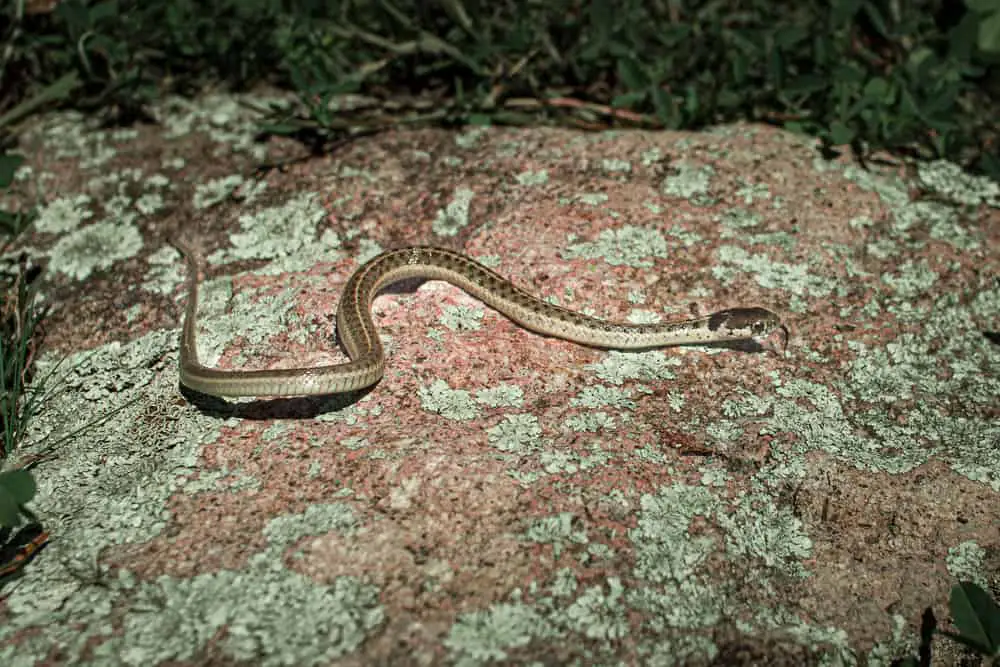
The Sierra Garter snake can be dark brown, blackish, or olive-brown. A light stripe runs on its back and sides but is not so clearly seen on its neck. They typically measure 18 to 38 inches.
They are found in coniferous forests, oak woodlands, chaparral, sagebrush, and pine juniper. They are always near water sources like rivers, creeks, small lakes, or meadow ponds, often located at elevations from 3000 to 8000 feet.
Their preferred prey are amphibians, fish, frogs, salamanders, tadpoles, and trout. They also eat the Pacific Newt, which is toxic to most other snakes.
They are not classed as a threatened species, but the introduction of American Bullfrogs can hurt their population.
Giant Garter Snake – Thamnophis gigas
The Giant Garter snake is the largest Garter snake found in the U.S. that measures 64 inches long with olive to brown color with a yellow stripe down the back and a light stripe down the body.
They can be found near wetlands, drainage and irrigation canals, ponds, streams, and small lakes.
They will move to higher ground during the winter away from flood zones. Hibernation starts in early November to April.
Giant Garter Snakes are classed as threatened and are believed to soon be in danger of extinction. These snakes face habitat loss, water pollution, fragmentation, predation from introduced species, changes in agricultural management practices, and road mortalities.
Two-striped Garter Snake – Thamnophis hammondii
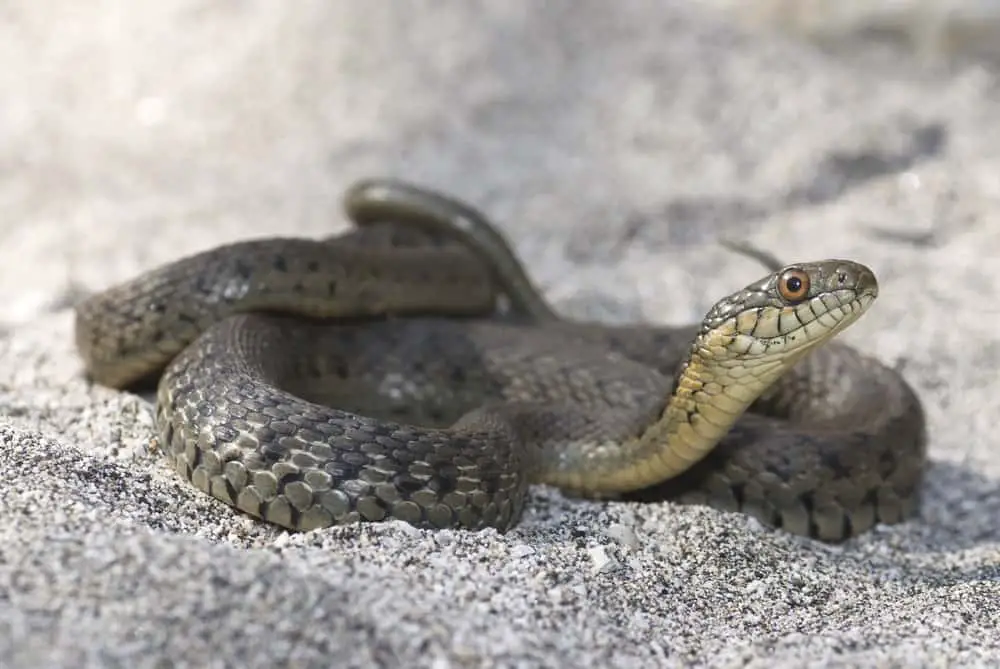
The Two-striped garter snake can be brown, olive, or dark gray with a light stripe on its neck.
Some snakes have yellow or gray stripes on the sides, and others have two rows of dark spots with no stripe. These snakes measure 18 to 30 inches long.
This snake is aquatic and likes habitats that are near water sources. Two-striped Garter Snakes like to feed on tadpoles, fish, fish eggs, tiny frogs, earthworms, newt larvae, leeches, earthworms, and toads. They will hold themselves underwater using their tail and then launch themselves at passing prey.
When this Garter Snake is threatened, it mimics a venomous snake by flattening its head into a triangular shape, and like other Garter snakes, release foul-smelling musk and defecate.
Habitat loss, destruction of wetlands, and drought caused a decline in their population.
Mexican Garter Snake – Thamnophis eques
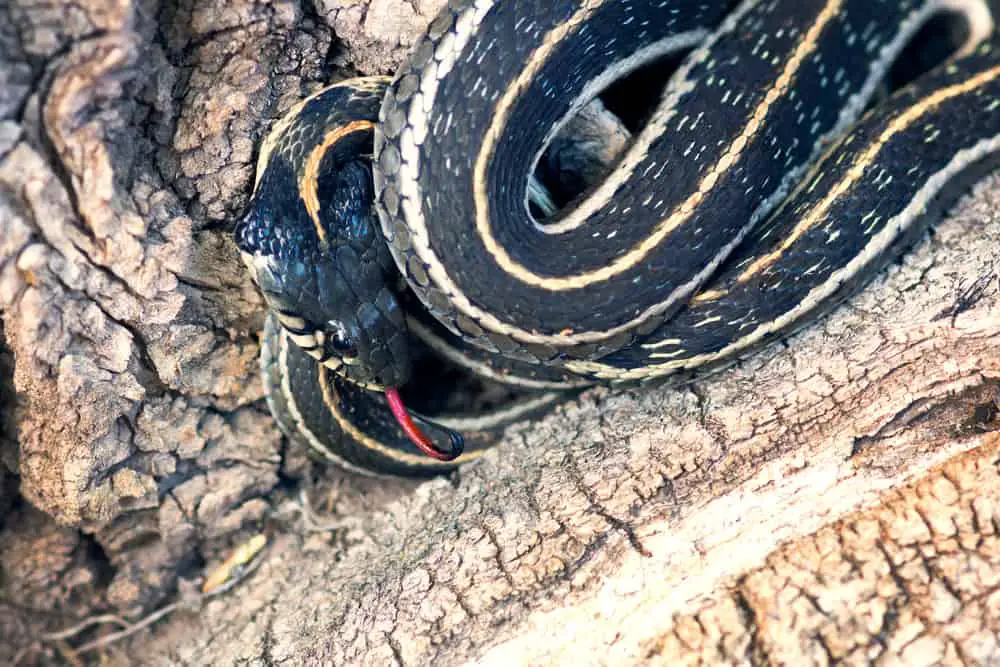
The Mexican Garter snake has several color varieties like rust, brown, olive, black, or tan with three yellow or creamy stripes, one on the back and one down the sides. Sometimes it has dark blotches on the side of its neck.
This snake has a much larger head than other Garter snakes with black outlined scales on its face. They measure 44 inches long.
The Mexican Garter snake is a secretive snake that is hard to find. They live near water sources with thick vegetation.
They are active in the mornings and early evenings. Another highly aquatic snake that likes to feed on fish and frogs.
The Mexican Garter snake has been listed as threatened under the U.S. Endangered Species Act since 2014. The introduction of non-native species and habitat loss have been the main contributors to their decline.
Short-headed Garter Snake – Thamnophis brachystoma

The Short-headed Garter snake is olive green with three yellow cream stripes, one on the back and each side bordered with small black spots with no clear distinction between the neck and head.
They measure 10 to 22 inches long. Their territories and populations are relatively, but you can find them in meadows, fields under logs and rocks. They mainly feed on earthworms, salamanders, leeches, fish, and frogs.
Short-headed Garter Snakes are docile and rarely bite but, if threatened, will defecate and give off foul-smelling musk.
Butler’s Garter Snake – Thamnophis butleri
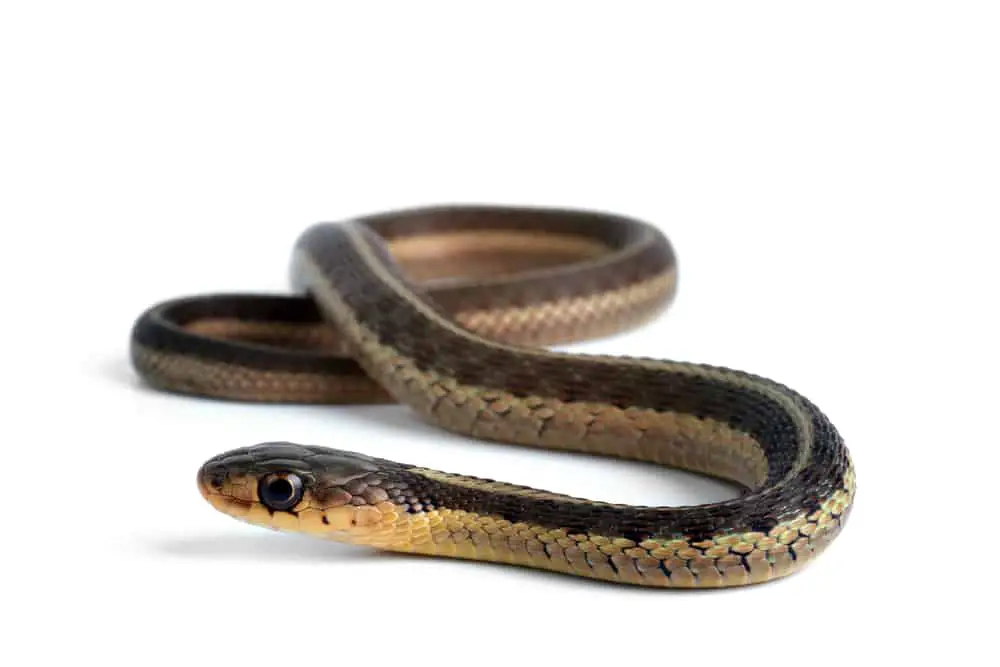
Butler’s Garter snakes are olive-brown or black with three orange or yellow stripes on the back and sides.
You might see two rows of dark spots between the back and side stripes. Their heads are small, and they measure 15 to 20 inches long. The Butler’s Garter Snakes and Eastern Garter snakes are almost identical.
The Butler’s Garter snake’s side stripe placements are what differentiate it. The stripes are centered on the third scale, row up from the large scales under the body.
They have a smaller head than other garter snakes and, when threatened, will thrash around on the spot instead of fleeing.
The Butler’s Garter snake is classed as endangered. Agricultural and industrial development caused major habitat loss. You can find them in grassland habitats under logs, rocks, and other objects that provide cover.
They prefer to eat insects, earthworms, and frogs. Butler’s Garter snakes are fastmoving in the long grass but move in a side-winding manner in non-vegetated habitat.
Conclusion
Garter snakes are harmless to humans and a vital part of the ecosystem by controlling populations of frogs and insects. They are small and medium-sized snakes that belong to the genus Thamnophis and can be found in Canada, North and Central America. With a variety of colors and their distinctive three-stripes, Garter snakes are easy to identify.
They are always found near water sources and often hunt in rivers and streams. There are many species and sub-species of Garter snakes, and we hope the eleven species we discussed in this article gave insight and understanding into the beautiful world of Garter snakes.
Sources:
Live Science: Garter Snakes
Savannah River Ecology Laboratory: Eastern Garter Snake
Everything Reptiles: Types of Garter Snakes
Animalia: Eastern Garter Snake



